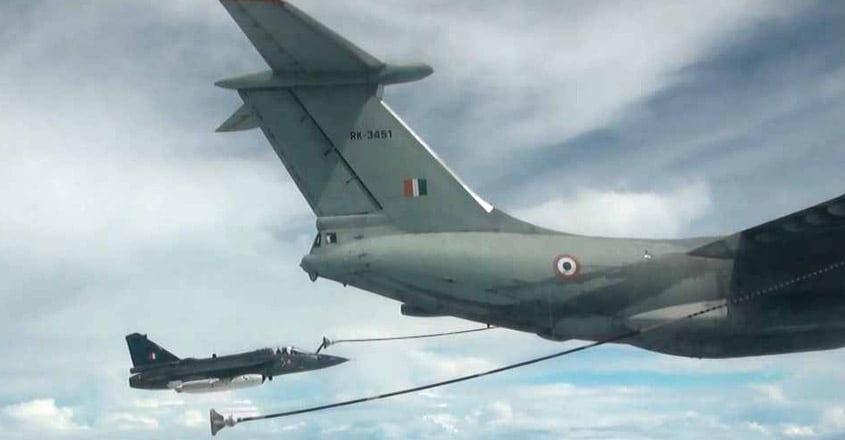Tejas clears critical hurdle with smooth air-to-air refueling

Mail This Article
Bengaluru: India’s Light Combat Aircraft (LCA) Tejas made its first ever air-to-air wet contact with an Indian Air Force (IAF) tanker over Gwalior on Monday during the ongoing trials to attain the Final Operational Clearance (FOC).
A Tejas variant (LSP-8) piloted by Wg Cdr Siddharth Singh made the wet contact with an IAF IL-78 tanker for the planned air-to-air refuelling. About 1,900 kg of fuel was transferred during the in-flight refuelling process at an altitude of 20,000 feet.
The LSP-8 is the only Tejas variant from the flight-line currently integrated with the probe that enables the smooth transfer of fuel from a tanker aircraft.
Monday’s performance of Tejas during the air-to-air refuelling has come in as a huge boost to the confidence of scientists and engineers at the Aeronautical Development Agency (ADA) and Hindustan Aeronautics Ltd (HAL). Work on the fuel system was undertaken by HAL and that of the refueling probe by ADA.
The tanker flew in from Agra while Tejas took off from the IAF Station, Gwalior. Ahead of the first wet contact today, LSP-8 underwent many trials to gauge various test profiles. The first dry contact was made on September 4 with Group Captain Joshi piloting the LSP-8, followed by another one on September 6.
Military sources who spoke to Onmanorama said the entire air-to-air trials were being carried out under the supervision of Group Captain Anup Kabadwal. The officer is said to have rich experience in in-flight refuelling of many IAF assets.
The fighter’s ability to perform in-flight refuelling is one of the crucial factors to achieve FOC.
During the trials, both Tejas and the IL-78 were flying at speeds of 270 knots, approximately 311 miles per hour. The performance of both aircraft was captured by LCA PV-5, which is a trainer from the flightline.

All the fighters and trainers post-FOC (Tejas Mk-1A) will be fitted with the probe, giving an edge to the platform during extended missions. HAL was earlier open to the idea of retrofitting all the initial 20 platforms of Tejas with the probe through a separate contract with IAF.
Challenges galore
Air-to-air refueling is one of the most challenging operations with the CG (centre of gravity) of the receiving platform shifting spontaneously after the fuel flow begins.
“Great sight to see the process but it involves fine flying qualities. The probe is exposed to air turbulences and that makes the contact difficult. It’s like trying to spot a needle hole at high speeds. Both platforms are moving at same speeds, but we are happy that the operation was successful at the first shot itself,” says an official part of the mission.
HAL said the performance of the fuel and flight controls systems during the trial was in-line with the design requirements and matched the results of ground tests of air-to-air refuelling system.
The Defence Research and Development Organisation said the enhanced range and endurance in air for Tejas would provide the IAF a host of options in exploiting the operational potential of the fighter.
The technical team from ADA was headed by Krishna Prasad and Gopal Yelawati from HAL.
“The results are due to the extreme work we have done on the simulation front. The specially modified control laws (CLAW) tuned in perfectly during the air-to-air mission today,” an official said.
Record attempt

Interestingly, Tejas might have set a new record for fighter development world over by making a wet contact during the initial week of a trial itself.
“If you look at any fighter programme world over, normally, it will take a minimum of six months to achieve a perfect shot. To get it right at the first attempt itself is a phenomenal achievement,” adds the official.
Ahead of today’s mission, dry contact was made with the left, right, and centre stations of the tanker earlier this month. (Three hoses come out of the tanker stations during the refuelling operations from three different sides. The drogue [shape of a funnel] is extended from the tanker by each hose and later it is locked on to the probe of plane set to receive the fuel).
“The wake of the tanker’s engine is different for all stations and we made contact with all the three smoothly. As the aircraft gets fuelled, the CG goes up. However, the handling qualities of Tejas has been very good and all systems performed in a robust manner,” the official said.
The IAF-ADA-HAL combine will now undertake more wet trials with a different set of pilots.
“It’s going to be a different set of readings all the time and we want to map the new set of pilot experiences emerging out of in-flight fuelling trials. There will be more trials till the end of the week. Hopefully, we should be done unless the IAF wants new set of points proven,” says the official.
Today’s mid-air refueling was in a pre-defined sequence taking into account the constant shifting of CG limits. Tejas carries fuel on both wings (700 litres each), fuselage (850 litres) and in two drop tanks (1,200 litres each).
Eminent scientist Dr Kota Harinarayana termed the successful test as historic.
“To prove a critical mission with our own systems is a great achievement,” he said.
(The writer is an independent aerospace, defence journalist and a strategic communication adviser, who blogs at Tarmak007 and tweets @writetake.)


